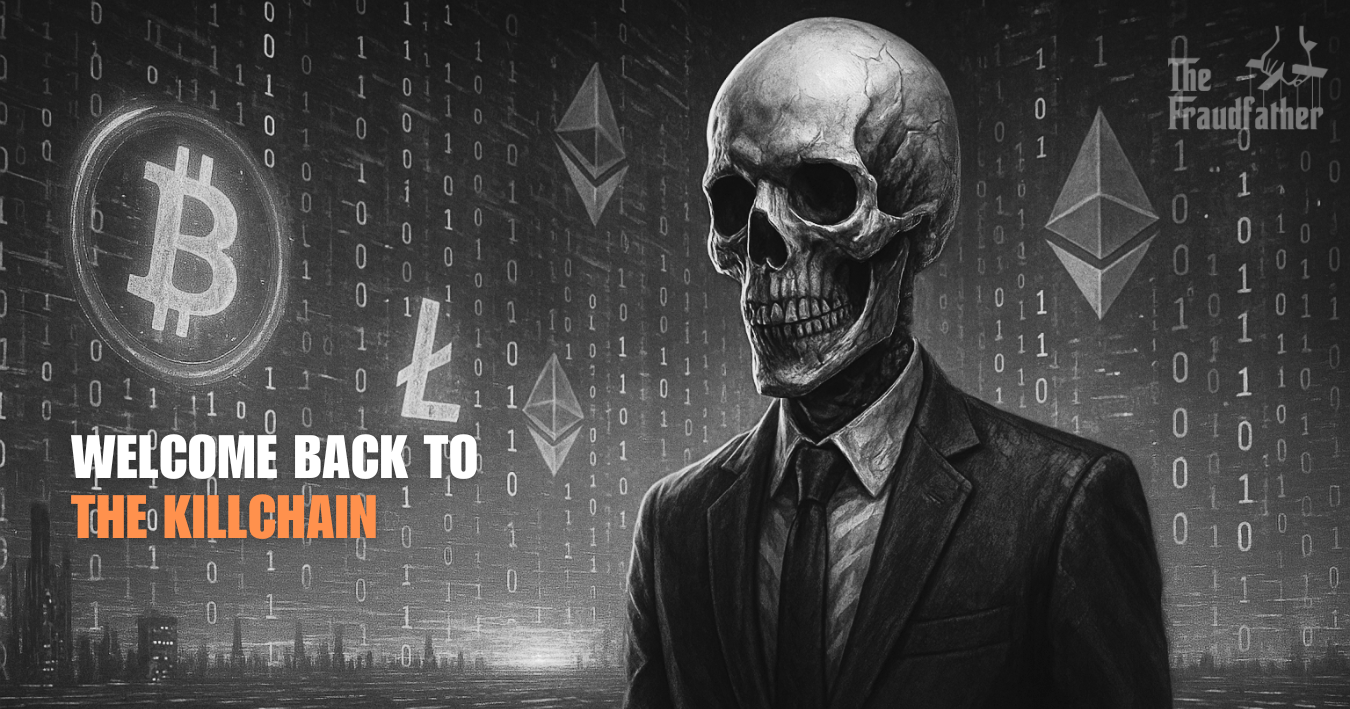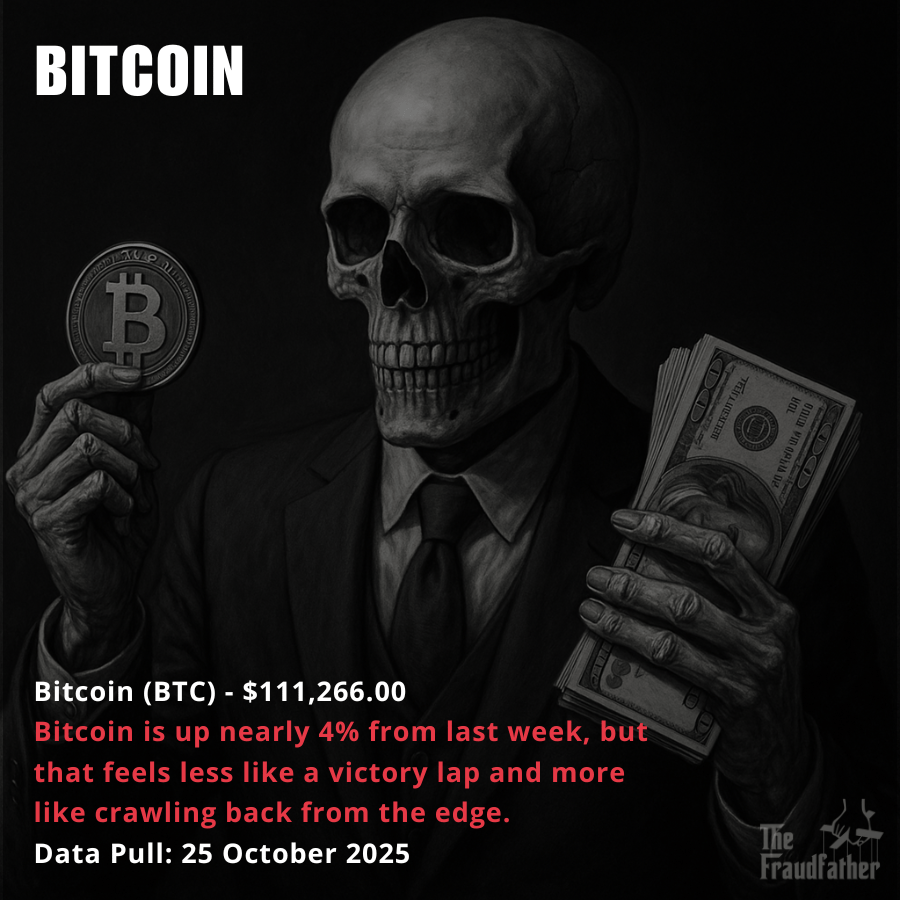- The KillChain
- Posts
- $15 Billion Bought Slavery. $2 Billion Bought a Pardon.
$15 Billion Bought Slavery. $2 Billion Bought a Pardon.
Blockchain exposed history's largest forced-labor operation, and crypto continued buying its way into the White House



Crypto had two defining moments this week. One reveals an industry exploited for industrial-scale human trafficking. The other reveals an industry that purchased a presidential pardon.
Two Stories, One Industry, Zero Shame
Crypto had two defining moments this week. One reveals an industry exploited for industrial-scale human trafficking. The other reveals an industry that purchased a presidential pardon. Both stories are true. Both happened within days of each other. And together, they tell you everything you need to know about where crypto stands in 2025.
Let's start with the bigger number.
The $15 Billion Slave Operation

Chen Zhi is 37 years old. He's a baby-faced billionaire who rose to the highest levels of power in Cambodia, where he runs one of the country's largest conglomerates.
Chen Zhi is 37 years old. He's a baby-faced billionaire who rose to the highest levels of power in Cambodia, where he runs one of the country's largest conglomerates. He bestows scholarships to students. He operates philanthropy programs. He advises the prime minister. The Cambodian government honored him with the title "neak oknha," essentially a lordship reserved for the country's most respected elite.
Behind this facade, U.S. prosecutors say Chen runs one of the largest transnational criminal organizations in Asia. An empire fueled by forced labor and cryptocurrency scams that, at its peak, was stealing $30 million every single day.
On October 14, the Justice Department unsealed an indictment charging Chen with wire fraud and money laundering conspiracy. In parallel, they announced the largest asset seizure in the department's entire history. Not the largest crypto seizure. The largest seizure of any kind, ever. 127,271 Bitcoin, worth approximately $15 billion, seized from wallets whose private keys Chen personally controlled.
Inside the Compounds
Chen's Prince Holding Group operates in more than 30 countries. Publicly, it focuses on real estate development, financial services, and consumer products. Privately, it operates at least 10 forced-labor compounds across Cambodia that function as modern slavery operations dedicated to pig butchering scams.
The mechanics are brutal and efficient. Criminal recruiters lure workers with fake job advertisements. When workers arrive in Cambodia, they discover they've been trafficked. The compounds are surrounded by high walls and barbed wire. Guards patrol the perimeter. Violence is frequent. Escape is nearly impossible.
Inside, workers are forced to execute pig butchering scams at industrial scale. One facility housed 1,250 mobile phones controlling 76,000 social media accounts. The phones sit on racks like server farms, automated systems blasting messages across dating apps, social media platforms, and messaging services. When a potential victim responds, the conversation gets forwarded to a human scammer who builds rapport over days or weeks before introducing the investment opportunity.
Chen personally maintained detailed records. Ledgers tracking profits. Documents describing which fraudulent schemes ran from which rooms. Photographs of the "phone farms." And according to prosecutors, Chen also kept photographs depicting the violence used to keep workers compliant. Images of beatings. Evidence of torture.
In one documented case, Chen allegedly authorized a beating with only one instruction: don't "beat him to death."
The Money Trail That Blockchain Exposed
Here's what matters: these scams aren't new. Pig butchering existed long before Bitcoin. For decades, similar operations used Western Union, wire transfers, and bank accounts to steal from victims. What changed isn't the scam. What changed is the transparency.
Blockchain's immutable ledger is what allowed investigators to trace $15 billion back to Chen's wallets. Every transaction is permanently recorded. Every movement of funds leaves a trail. The same technology that criminals thought would provide anonymity became the evidence that enabled the largest seizure in DOJ history.
The money flowed through bitcoin mining operations in Laos, shell companies across Southeast Asia, and criminal partnerships spanning continents. One facility, the Jin Bei Casino Hotel, operated openly as a luxury resort while functioning as a scam compound. According to a 2022 FBI investigation, 259 Americans lost $18 million at just that one location. Chen operated at least 10 compounds.
The stolen funds bought Picasso paintings, private jets, properties in London, yachts, watches, and critically, bribes to Cambodian officials who protected the operation. Chen served as personal advisor to Prime Minister Hun Manet. His political connections made him essentially untouchable inside Cambodia.
Americans lost over $10 billion to Southeast Asian pig butchering scams in 2024 alone, a 66% increase from the year before. The UN estimates roughly 100,000 people are currently held in similar scam compounds across Cambodia and Myanmar.
This week, the U.S. Treasury designated Prince Group as a transnational criminal organization and sanctioned 146 associated individuals and entities. The UK coordinated parallel seizures.
Chen remains at large, somewhere in Cambodia with tens of billions in net worth. The scam compounds continue operating. But now, because of blockchain transparency, investigators can track every dollar.
The Presidential Pardon That Cost $2 Billion

You know him as CZ. He founded Binance, the world's largest cryptocurrency exchange. In November 2023, he stood in a Seattle federal courtroom and pleaded guilty to violating the Bank Secrecy Act.
Now let's talk about Changpeng Zhao.
You know him as CZ. He founded Binance, the world's largest cryptocurrency exchange. In November 2023, he stood in a Seattle federal courtroom and pleaded guilty to violating the Bank Secrecy Act. The charge: failing to maintain an effective anti-money-laundering program at Binance, enabling the platform to process $900 million in transactions connected to child sex abuse, drug trafficking, and terrorism.
CZ agreed to step down as Binance's CEO, pay a $50 million fine, and serve time in federal prison. Binance itself paid $4.3 billion in penalties.
Then-Attorney General Merrick Garland: "Binance became the world's largest cryptocurrency exchange in part because of the crimes it committed."
Then-Treasury Secretary Janet Yellen: "Binance turned a blind eye to its legal obligations in the pursuit of profit. Its willful failures allowed money to flow to terrorists, cybercriminals, and child abusers through its platform."
Federal prosecutors asked for three years in prison. The judge sentenced CZ to four months. He served his time and was released in 2024.
On October 23, 2025, President Donald Trump pardoned him.
The Timeline That Matters
In September 2025, Binance hired lobbyist Charles McDowell, a personal friend of Donald Trump Jr. The lobbying firm disclosed that Binance paid $450,000 for one month of work seeking "executive relief" from the White House.
In October 2025, MGX, an investment firm backed by the United Arab Emirates, announced a $2 billion investment in Binance using USD1, a stablecoin created by World Liberty Financial.
World Liberty Financial is a crypto company founded by Donald Trump, Donald Trump Jr., and Eric Trump. The $2 billion transaction was effectively a massive deposit into the Trump family's crypto infrastructure, which is hosted on Binance's platform. Since the 2024 election, the Trump family's crypto ventures have generated approximately $4.5 billion.
Days after the MGX investment was announced, Trump pardoned CZ.
When asked about the pardon, Trump said: "I don't know, he was recommended by a lot of people. A lot of people say that he wasn't guilty of anything. I gave him a pardon at the request of a lot of very good people."
Trump claimed he doesn't believe he's ever met CZ.
Senator Elizabeth Warren: "First, Changpeng Zhao pleaded guilty to a criminal money laundering charge. Then he boosted one of Donald Trump's crypto ventures and lobbied for a pardon. Today, Donald Trump did his part and pardoned him."
BNB, the cryptocurrency associated with Binance, jumped 15% within minutes of the pardon announcement.
What Blockchain Actually Changed
Let's be precise about what's happening here.
Scams are not new to crypto. Pig butchering existed with wire transfers and Western Union for decades. Money laundering happened through traditional banks long before Binance. Forced labor has powered criminal enterprises throughout history. Presidential pardons have always been for sale to those with enough money and connections.
Crypto didn't invent any of this.
What crypto changed is the unit of exchange, the speed of transactions, and critically, the transparency of the money trail. Blockchain's permanent ledger means every transaction is traceable. The same technology that enables financial freedom also enables investigators to seize $15 billion from a criminal network. The same transparency that criminals thought would protect their anonymity became the evidence that exposed their operation.
Traditional banking scams left paper trails that could be destroyed, manipulated, or hidden behind banking secrecy laws. Cryptocurrency scams leave permanent, immutable records on a public ledger that anyone can analyze. Chen's $15 billion seizure happened because blockchain transparency made it possible to trace every transaction back to wallets he controlled.
That's the paradox. The technology didn't create the crime. It exposed it.
The Industry's Uncomfortable Truth
Same week. Same industry. Two stories that reveal crypto's maturation into an institutional asset class while simultaneously exposing how that same technology gets weaponized by criminals and corrupted by politics.
One story: a criminal operation so sophisticated it industrialized human trafficking to power billion-dollar scams, but blockchain transparency enabled the largest seizure in DOJ history and provided evidence that would have been impossible to gather using traditional financial systems.
The other story: a convicted money launderer whose company facilitated terrorism financing received a presidential pardon days after investing billions in the president's family business, demonstrating that regulatory capture and political corruption transcend any particular payment technology.
This is what institutional adoption looks like in practice. Wall Street has arrived. Fidelity offers Solana alongside Bitcoin and Ethereum. JPMorgan accepts crypto as loan collateral. Spot Bitcoin ETFs have absorbed 18% of circulating supply. The infrastructure is legitimized. The regulatory framework is clarifying. Bitcoin holds $111,000.
But the same transparency that makes blockchain revolutionary for financial freedom also makes it revolutionary for law enforcement. The same speed that enables instant global transactions also enables instant global theft. The same decentralization that removes banks as gatekeepers also removes banks as filters for criminal activity.
Scams aren't new. Corruption isn't new. What's new is that now every transaction lives forever on a public ledger, which means investigators can follow the money in ways that were impossible with traditional finance, and criminals can move money in ways that are faster than traditional enforcement can stop.
What This Means for You
As we analyze Bitcoin holding $111K, Ethereum struggling below $4K, and Solana collecting Wall Street validation, understand what you're analyzing.
This isn't an industry that created scams. This is an industry built on technology that makes scams more traceable and seizures more possible, while simultaneously making transactions faster and harder to stop in real time. The forced-labor camps existed before crypto. The presidential pardons happened before crypto. What changed is that now, the money trail is permanent and public.
That's crypto in 2025. A technology that simultaneously enables and exposes, that liberates and entraps, that creates transparency while moving too fast for traditional oversight. The house always wins. But now, at least, everyone can see how. Now let's see how these forces e.g. institutional adoption, regulatory shifts, and yes, even exposed criminality, are moving the markets.
Got a Second? The KillChain reaches 5,000+ readers every week including security professionals, executives, and anyone serious about understanding crypto. Know someone who needs this intelligence? Forward this newsletter.
Crypto’s Most Influential Event
This May 5-7 in 2026, Consensus will bring the largest crypto conference in the Americas to Miami’s electric epicenter of finance, technology, and culture.
Celebrated as ‘The Super Bowl of Blockchain’, Consensus Miami will gather 20,000 industry leaders, investors, and executives from across finance, Web3, and AI for three days of market-moving intel, meaningful connections, and accelerated business growth.
Ready to invest in what’s next? Consensus is your best bet to unlock the future, get deals done, and party with purpose. You can’t afford to miss it.

The Recovery That Wasn't (Or Was It?)
Two weeks ago, Bitcoin touched $126,500. You probably remember what happened next. Trump announced 100% tariffs on Chinese goods, and the market vaporized $19 billion in leveraged positions faster than you could say "risk management." Bitcoin cratered 12% in hours. Ethereum dropped 15%. Solana got hammered for 30%. The altcoin graveyard filled with coins down 70% or more.
This week, you're looking at a market that's trying to figure out if it survived a stress test or if it just got its first glimpse of what's coming.
What This All Means
October was supposed to be "Uptober," the month where crypto historically posts 20%+ gains. Instead, it opened with a new all-time high, then delivered the largest liquidation event in history, and now sits in an uncomfortable middle ground where nobody's sure what happens next.
Bitcoin is up 4% month-to-date. Ethereum is down 5%. October's historical average is closer to 20%. The market isn't following the script.
Some analysts are calling October the last exit window before a prolonged bear market. Their reasoning is based on cycle models, on-chain metrics, and technical patterns that all point to a potential top. Others argue that institutional adoption through ETFs, sovereign accumulation, and regulatory clarity will push Bitcoin to $200,000 by year-end.
Both can't be right.
What we know for certain is this. The market just survived its largest liquidation event ever and is still standing. Institutions are accumulating through dips despite short-term outflows. Major financial players like Fidelity and JPMorgan are integrating crypto into their core offerings. Asia is moving faster than the U.S. on product approvals.
The October 10 crash flushed out over-leveraged positions and reset sentiment. Whether that was a healthy correction or the beginning of something worse depends entirely on what happens in the next few weeks. Watch the $114,500 level on Bitcoin. Watch whether Ethereum ETF outflows continue or reverse. Watch whether Solana can hold its institutional momentum.
And if you're new to crypto and terrified by the volatility, understand this: a $19 billion liquidation event is a feature, not a bug. Leverage gets punished. Weak hands get shaken out. The market resets. Then it decides which direction to move next.
Right now, it's still deciding
Battlefield Intelligence: What the Numbers Truly Reveal.

Bitcoin: $111,266 They're Buying While You're Panicking
Bitcoin is up nearly 4% from last week, but that feels less like a victory lap and more like crawling back from the edge. The October 10 liquidation event was the largest in crypto history. Not just this cycle. Ever. And Bitcoin is still trading 12% below its early October peak.
Here's what makes this interesting. While retail traders were getting liquidated into oblivion, a specific cohort of investors was buying. Wallets holding between 100 and 1,000 BTC have accumulated roughly 907,000 Bitcoin over the past year. These aren't degenerate gamblers on 50x leverage. These are entities with capital and conviction, buying through every dip.
The ETF story tells you everything about institutional psychology right now. Early October saw record inflows of $3.55 billion into Bitcoin ETFs in a single week. Then came the crash. Last week, Bitcoin ETFs recorded their second-largest outflows ever at $1.23 billion. This week? $446 million back in.
What you're witnessing is institutions taking profits after a parabolic run, getting spooked by volatility, then slowly building positions again. BlackRock's IBIT now holds $87.7 billion in assets. ETFs have absorbed 18% of Bitcoin's entire circulating supply. When that much capital moves in and out, you get whipsaw price action.
Bitcoin has tried multiple times this week to break above $113,000. It failed every time. The 50-day and 200-day moving averages are clustering right around $114,500. If Bitcoin clears that level with conviction, you're looking at a run toward $120,000. If it fails, expect a retest of $106,000.
One more thing. Trump pardoned Binance founder CZ this week, calling his prosecution part of a "war on cryptocurrency." Whether you think this is justice or cronyism, it signals that Washington's stance toward crypto has fundamentally shifted. JPMorgan is now accepting crypto as loan collateral. The Fed held a conference on integrating crypto into payment rails. This is not the same market that existed even six months ago.

Ethereum: $3,933 The Underperformer With a Supply Problem
Ethereum is the quiet underperformer right now, up just 1.4% from last week while Bitcoin and Solana post bigger gains. But the on-chain metrics tell a more interesting story than the price action suggests.
Exchange supply just hit a nine-year low. Ethereum is disappearing from exchanges at a rate we haven't seen since 2016. This typically happens when holders are staking, moving coins to cold storage, or preparing for a move higher. Standard Chartered raised its Ethereum price target to $7,500 based on this supply crunch and continued institutional accumulation through ETFs.
But here's the problem. While Bitcoin ETFs saw $446 million in inflows this week, Ethereum ETFs bled $243.9 million. That's the second consecutive week of outflows. BlackRock's ETHA alone lost over $100 million. The week before? $311 million out the door.
Institutions are rotating from Ethereum into Bitcoin. The logic is simple. When markets get volatile and regulatory uncertainty persists, capital flows to the asset with the strongest narrative. Bitcoin is digital gold. Ethereum is a technology platform with execution risk. In a flight to safety, Bitcoin wins.
Ethereum's RSI hit its most oversold reading since April 2025. Historically, that's preceded powerful rallies. The network fundamentals remain strong despite lagging price action. Ethereum still dominates in developer activity and remains the backbone of DeFi. But right now, the market doesn't care about fundamentals. It cares about momentum.
Ethereum needs to reclaim $4,000 and hold it. The next resistance sits at $4,260. Clear that with volume, and $5,000 becomes the target. Fail, and you're looking at consolidation between $3,900 and $4,000 until a catalyst emerges.

Solana: $191.85 Wall Street Finally Gets It
Solana is having a week. Up 3.3% from last week's close, but more importantly, it's collecting institutional validation at a pace that would've seemed impossible two years ago.
On October 23, Fidelity added Solana to its platform alongside Bitcoin, Ethereum, and Litecoin. Fidelity manages trillions. This isn't some random exchange listing Solana for trading fees. This is Wall Street's largest brokerage telling its clients that Solana belongs in the same conversation as the top crypto assets.
Then Hong Kong approved Asia's first Spot Solana ETF, which starts trading October 27. Fully backed by physical SOL, managed by ChinaAMC. While the U.S. is still debating Solana ETF applications, Asia is moving forward.
The network proved itself during the October 10 chaos. While other chains buckled under the load, Solana processed record DEX volumes without breaking a sweat. Its 24-hour DEX volume hit $94.8 billion, exceeding Ethereum's. When the chips were down and every trader on the planet was panic-selling at once, Solana's throughput held up.
About 75% of SOL is locked in staking, which reduces sell pressure and creates a supply squeeze. Options markets are showing bullish momentum, with the 25-delta risk reversal positive across all expiries. That means more people are betting on Solana going up than hedging against it going down.
Solana is consolidating around $190-192. The key levels to watch are $197 support and $215 resistance. A clean break above $215 with volume opens the door to $250. Lose $183, and you're back to testing lower supports.
⚠️ The KillChain Disclaimer ⚠️
Informational & Educational Use Only
All content in this newsletter, including but not limited to market commentary, tactical read-outs, “buy-zone” language, and any linked training materials, is provided strictly for general, educational, and informational purposes. Nothing herein constitutes (or should be interpreted as) personalized investment, legal, accounting, or tax advice.
No Investment Recommendations
References to “accumulate,” “scale in,” “trim,” or similar calls to action are illustrative frameworks, not specific recommendations to buy, sell, or hold any digital asset, security, or derivative. You alone are responsible for evaluating the merits and risks associated with any use of the information provided before making any investment or trading decision. Consult a registered investment adviser or other qualified professional regarding your individual circumstances.
About the FraudFather:
The Fraudfather didn’t learn fraud from influencers or movies. He learned it chasing terrorists, flipping money launderers, and dismantling multi-million-dollar schemes, before most people knew what “DeFi” meant.
A former Senior Special Agent and Supervisory Intelligence Operations Officer, he spent over two decades tracking financial predators across borders, blockchains, and bureaucracies. From dark web forums to government war rooms, he’s seen every lie and loophole up close.
Now a “recovering” digital identity and cybersecurity executive, he’s turned his sights to teaching crypto, where old scams wear new skins, and smart contracts get played like slot machines.
Through The Fraudfather persona, he’s exposing how fraud really works on-chain:
How social engineers bypass wallet security
How cross-chain laundering pipelines stay hidden
How scammers weaponize human psychology faster than regulators can blink
This isn’t theory.
It’s operational intelligence, on-chain and in near real time.
Follow the Fraudfather and stay five moves ahead of the next exploit

